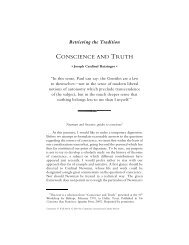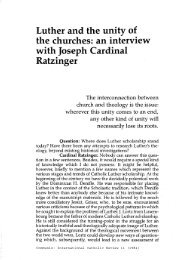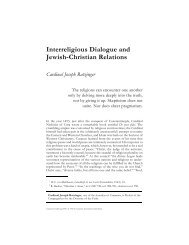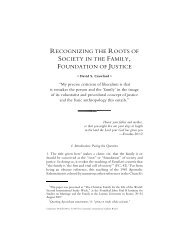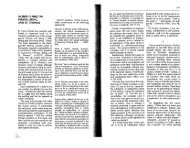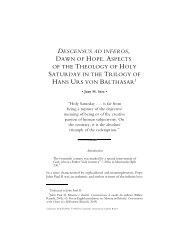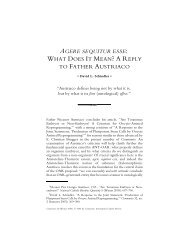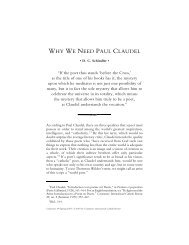W. Norris Clarke. Person, Being, and St. Thomas. Communio 19 ...
W. Norris Clarke. Person, Being, and St. Thomas. Communio 19 ...
W. Norris Clarke. Person, Being, and St. Thomas. Communio 19 ...
Create successful ePaper yourself
Turn your PDF publications into a flip-book with our unique Google optimized e-Paper software.
608 W. Nowis <strong>Clarke</strong><br />
substance, <strong>and</strong> an "extroverted," or towards-othms dimension,<br />
as relational through action.<br />
Let us conclude this section with a quotation from<br />
Josef Pieper, who, more than most contemporary Thomists,<br />
has brought out the proportional connection between the sub-<br />
stantial <strong>and</strong> relational aspects of being:<br />
To sum it up, then: to have (or to be) an "intrinsic existence" means<br />
"to be able to relate" <strong>and</strong> "to be the sustaining subject at the center of<br />
a field of reference". . . . Only in reference to an inside can there be<br />
an outside. Without a self-contained "subject" there can be no<br />
This dynamic polarity between substance <strong>and</strong> ac-<br />
tion-plus-relations was submerged <strong>and</strong> almost forgotten in the<br />
post-medieval period from Descartes on. Three major distor-<br />
tions of the classical notion of substance broke the connection:<br />
(1) the Cartesian notion of the isolated, unrelated substance,<br />
"that which needs nothing else but itself (<strong>and</strong> God) to exist";<br />
(2) the Lockean static substance, the inert substratum needed to<br />
support accidents but unknowable in itself; <strong>and</strong> (3) the separa-<br />
ble substance of Hume, which, if it existed, would have to be<br />
empirically observable as separated from all its accidents, <strong>and</strong><br />
hence is an impossible fiction.<br />
Because these emasculated versions of substance<br />
were the only ones familiar to them from classical modern phi-<br />
losophy, a large number of modern <strong>and</strong> contemporary thinkers<br />
have simply rejected substance entirely as a nonviable mode of<br />
being, e.g., Bergson, Collingwood, Whitehead, Dewey, Heideg-<br />
ger, most phenomenologists, <strong>and</strong> many others. As a result, the<br />
person tended to be reduced to nothing but a relation or set of<br />
relations. The difficulty, here, however, as Pieper warned, is<br />
that if the substance, or in-itself, pole of being is dropped out,<br />
the unique interiority <strong>and</strong> privacy of the person are wiped out<br />
15Josef Pieper, The Truth of all Things, reprinted in the Living the Truth (San<br />
Francisco: Ignatius Press, <strong>19</strong>89), 83 <strong>and</strong> 82.<br />
<strong>Person</strong>, being, <strong>and</strong> <strong>St</strong>. <strong>Thomas</strong> 609<br />
also <strong>and</strong> the person turns out to be an entirely extroverted<br />
bundle of relations, with no inner self to share with others. But<br />
there is no need for this eitherlor dichotomy between substance<br />
<strong>and</strong> relation, once the notion of substance as center of activ-<br />
ity--<strong>and</strong> receptivity-has been retieved. To be is to be sub-<br />
stance-in-relation.<br />
Application to the person<br />
For <strong>St</strong>. <strong>Thomas</strong>, personality in the ontological<br />
sense, i.e., to be a person, is rooted in the act of existing: to be<br />
o be an intellectual nature possessing its own<br />
ue act of existing so as to be the autonomous source of its<br />
actions. Thus, in the theological application of the doc-<br />
re of Christ is complete as a nature, but<br />
t of existing, so it is not a human person,<br />
rsonal act of existence of the Second<br />
ow the person, for Aquinas, "is that<br />
all of nature." But since the act of<br />
t of all perfection, it follows that to be<br />
ed on to being from without, but<br />
n of being, itself, being come into its<br />
, allowed to be fully what it tends to be by<br />
estricted by the limitation proper to the ma-<br />
g, with self-dispersal over space that is char-<br />
In a word, when being is allowed to be fully<br />
ecessarily turns into luminous self-<br />
r self-consciousness-one of the<br />
of person. To be fully is to be personally.<br />
All this is clear enough in Aquinas himself. But<br />
ation follows from this rooting of<br />
at its supra-material levels-an<br />
ght out explicitly, or at least was<br />
by him. <strong>Being</strong> is not just presence,<br />
ture to pour over into active<br />
unication to others. And if<br />
ally being itself only at its supra-material<br />
that to be a person as such is to be a being<br />
nature to pour over into active, conscious self-<br />
<strong>and</strong> self-communication to others, through intel-<br />
together. And if the person in question is<br />
htly ordered in its conscious free action,<br />
ce to others will take the form of willing



